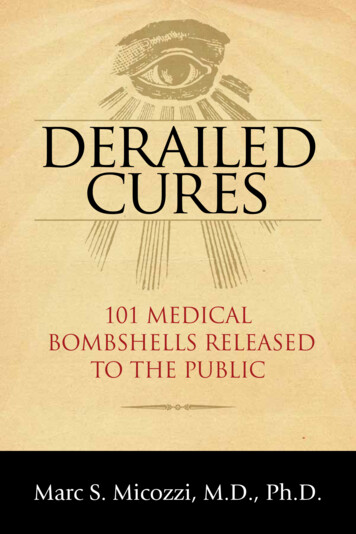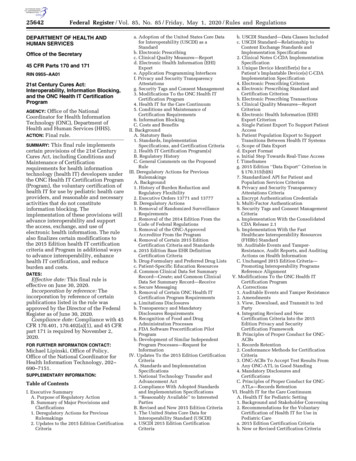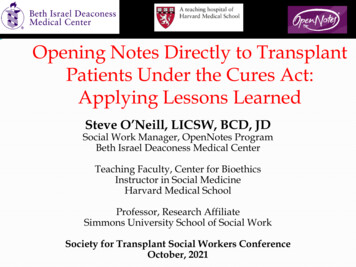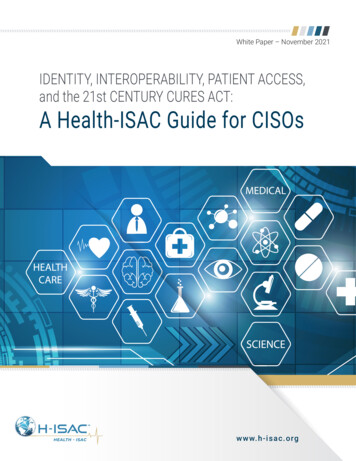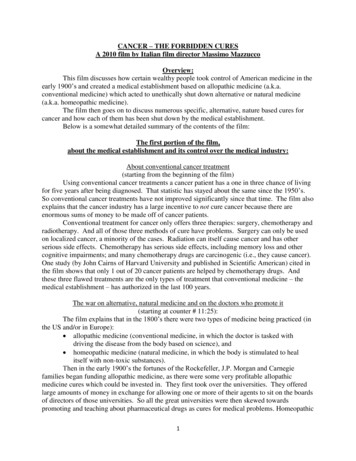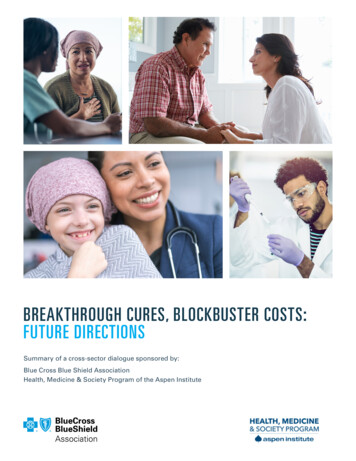
Transcription
BREAKTHROUGH CURES, BLOCKBUSTER COSTS:FUTURE DIRECTIONSSummary of a cross-sector dialogue sponsored by:Blue Cross Blue Shield AssociationHealth, Medicine & Society Program of the Aspen Institute
EXECUTIVE SUMMARYTransformative pharmaceutical products that can cure or treat onceseemingly intractable medical conditions are coming onto the marketin growing numbers, especially in the areas of genetic and cellulartherapies and tissue engineering. Known as Advanced Therapies,these biomedical breakthroughs often treat rare indications and canbe very costly to discover, develop, and produce. In part owing tohigh development costs and small markets, profits on these drugsare recouped over fewer patients and carry large price tags. Indeed,five such therapies approved from August 2017-May 2019 carry listprices that range from 373,000 to 2.125 million.1 While follow-oninnovation offers the potential to lower the expense of developmentand manufacturing and could translate into lower costs in a properlyincentivized system, their prices nonetheless impact overall healthcare spending and could have the unintended consequence ofcrowding out other important services.THE LIST PRICE FOR5 APPROVEDADVANCEDTHERAPIESFROM AUGUST 2017TO MAY 2019 RANGEDFROM 373,000TO 2.125 MILLION1Even if the cost of developing and manufacturing these therapiesdrops, capturing their economic benefits remains a challenge.The current financing system was designed to consider actuarialrisks on an annual basis, not to handle situations in which ashort course of treatment is expected to have a very long-termFigure 1. Level of concern regarding managing the financial risk and impact of high-cost durabletherapies, by payer segment (n 153). %10% 10%7%0%0%0%Commercial Fully Insured(n 55)Not at all a concernSlight concern2%0%Medicaid(n 42)Moderate concern2%0%Medicare Advantage(n 46)High concernSelf-Insured Employer(n 10)Extremely high concernSOURCE: MIT NEWDIGS. (October 11, 2019). FoCUS White Paper. Survey results–Payer perspectives on financing and reimbursement of one-time high-cost durable 44.pdfBreakthrough Cures, Blockbuster Costs: Future Directions 3
therapeutic effect, as in the case of Advanced Therapies. Virtually all payers (Medicare, Medicaid,commercial insurers, self-insured large employers, and others) have expressed significant concernsabout the potential burden of covering their cost, especially as the number of these products grows.2At the same time, developers have at times turned away from promising Advanced Therapy researchfor commercial, not clinical, reasons and fear that the growth of genetic therapies and related advancescould be stunted without supportive pricing, financing, and coverage policies.3 For their part, patientsare concerned that the industry may lack incentives to pursue some promising products, especially forvery rare diseases, or that payers will fail to cover their costs.While the federal government has made various policy accommodations to encourage and expedite theresearch and development of breakthrough drugs, there have been no corresponding adaptations inhow such products are paid for, once approved. The stakeholder consensus is that without innovativepricing and payment strategies, corporate, state, and national budgets could eventually be overwhelmed,industry could reduce its pursuit of some long-shot research into rare diseases and debilitating illnesses,and patients could be denied access to medical advances with extraordinary promise.In early 2020, the Blue Cross Blue Shield Association and the Health,Medicine & Society Program of the Aspen Institute convened aworking group of 15 leaders from industry, academia, government, andpatient advocacy groups to accelerate discussions about AdvancedTherapies and consider alternative financing frameworks to enhanceaccess to these high-priced and potentially life-transforming products.Two former FDA commissioners—Scott Gottlieb (2017 to 2019) andMargaret Hamburg (2009 to 2015)—co-chaired the group. Alan Weil,editor-in-chief of Health Affairs, moderated the discussions. (SeeAppendix for list of participants.)Over a day-and-a-half, participants explored the pricing, financing, access, decision-making, ethicalconsiderations, and data-collection dimensions of the growing wave of Advanced Therapiesexpected to provide enormous benefits to patients who currently lack medications that could savetheir lives or improve them dramatically. The conversation touched on various aspects of the broadecosystem for biomedical product innovation, which involves investors, pharmaceutical companies,regulators, payers, patients, and the taxpaying public.While the dialogue was wide-ranging and thoughtful, it came with no expectation of identifyingdefinitive solutions to an evolving and complex set of issues. The meeting was instead designed to layout consensus themes that merit deeper exploration, recognizing that Advanced Therapies can moveefficiently through the development and distribution pipeline only when the relevant players, policies, andprograms are aligned. Ultimately, of course, the goal was to identify strategies that will sustain the healthcare system while making Advanced Therapies available and affordable to those who need them.4 Breakthrough Cures, Blockbuster Costs: Future Directions
KEY FINDINGSThese are the group’s key findings:¾ It is imperative that anyone who can benefit from lifesaving Advanced Therapies be able toaccess them. Improving the health of people in need is the overarching goal of developing novelfinancing mechanisms to pay for these therapies.¾ Current mechanisms to pay for Advanced Therapies are inadequate to ensure long-termsustainability. Society needs to consider the broader health and social system opportunity costsof different pricing and payment models and develop innovative new strategies for at least someof the therapies with blockbuster costs.¾ Price and value must be part of any dialogue on payment strategies. The launch prices forAdvanced Therapies are not necessarily a given and merit scrutiny, especially since the initialdiscoveries leading to their development are often funded, at least in part, by taxpayers.Understanding the risks and costs throughout the drug production pipeline, as well as the benefitsthey deliver to patients, is needed to assess price and value.¾ The incentives that motivate product developers to pursue pioneering cures and treatment forrare diseases should be recognized and appreciated in order to ensure continued innovation.¾ Outcomes or value-based payment models hold promise, particularly for treatments that offerimmediate benefits or reduce otherwise needed care. To adapt these and other current financingapproaches to emerging Advanced Therapies, better ways to assess clinical performance overtime must be created.¾ Although Advanced Therapies are sometimes called “cures,” their long-term utility has notgenerally been established at the time of market entry owing to their novelty, and their durabilityis not fully established. Collecting rigorous, longitudinal data while minimizing the burden ofpatient data collection through registries that track outcomes is essential to inform experimentswith novel financing.¾ Society must create the right tools and venues to give patients meaningful input as valueequations are considered. Beyond sharing anecdotes of clinical experience and emotionalimpact, patient feedback must be considered as part of regulatory, pricing, and access decisions.¾ Existing regulatory policies should be thoroughly reviewed both to identify possible barriers toaccess, innovation, and competition and also to foster continued innovation and access to AdvancedTherapies. Such review should include policies related to the financing, pricing, and purchasing ofAdvanced Therapies, such as Medicaid best-price requirements and the Orphan Drug Act.¾ Risk pooling or stop-loss mechanisms may be necessary to distribute the costs of advancingtreatments and cures equitably in order to share benefits widely.Breakthrough Cures, Blockbuster Costs: Future Directions 5
FRAMING THE PROBLEMThe remainder of this paper captures highlights of the discussionthat generated these findings. Additional background was providedin a paper circulated prior to the meeting, which placed the issues intheir larger context.4 That paper reviewed the state of the science, themechanisms currently in place to pay for approved pharmaceuticalproducts, and the options that have been proposed to cover the highcosts of Advanced Therapies.Due to the COVID-19 pandemic, the world changed considerably inthe year that followed the meeting. Pressures on health care deliverysystems, constraints on spending, new thinking about how to approachR&D given the rapid-fire development of coronavirus vaccines, politicalshifts, and a deepened appreciation for the critical role that science andtechnology play in advancing health have all shifted the environmentin various ways. These developments, and others sure to follow,underscore the imperative of designing responsive, dynamic systemsthat can accommodate the evolving science, technology, and policyframework for Advanced Therapies.“No one is admittingthat the system isfailing. It’s not justthat we have inequity,it’s that what we haveright now cannotcorrect the inequity.”–Brian Wallach,I AM ALSThe potential to cure or transform the lives of patients with rare diseases, and ultimately to applyresearch advances to conditions that affect larger numbers of people, such as those with cancer orAlzheimer’s disease, is at an inflection point, generating tremendous excitement within the patient,scientific, and medical communities. More than 1,220 clinical trials of Advanced Therapies areunderway, according to the Alliance for Regenerative Medicine.5 Approximately two-thirds of the trialsare focused on oncology; the next most popular categories are neuromuscular and central nervoussystem disease groups, at five percent apiece.Advanced Therapy ClinicalTrials Underway5OtherNeuromuscularDiseasesNervous SystemDiseases6Oncology Breakthrough Cures, Blockbuster Costs: Future DirectionsAs growing numbers of novel treatmentsand cures complete the US Food and DrugAdministration (FDA) approval process andenter the marketplace, prices will remain high.Estimates from the Massachusetts Instituteof Technology indicate that up to 90 gene andcellular therapies are likely to be approved by2031 and used by a total of 550,000 patients.Based on the pricing of past products, annualacquisition costs for 90 new AdvancedTherapies will equal 30B.6 (Note that this doesnot account for offsets in the cost of usual careand improvements in productivity and quality of
life resulting from better outcomes or for the added expenses associated with the ancillary medical servicesthat accompany treatment.)The escalating financing challenges reflect innovations within the complex system that guides theirresearch, development, and marketing. While most Advanced Therapies that have been approvedrecently, or are in the research pipeline, are for rare diseases with very limited treatment options,indications for their use are likely to grow over time. That expands hope for the 10 percent of the USpopulation that is dealing with some type of rare condition,7 it further complicates the pricing equation.While it can be easy to talk in abstractions about access to medical breakthroughs, and the merits ofmaking therapy available to all who might benefit, a patient’s story adds another layer of meaning tothe conversation. Aliya Rinaldi, a 35-year-old patient advocate with beta-thalassemia, a rare form ofanemia, clarified the stakes for the group. When she was an infant, doctors told her parents that shewas unlikely to reach her 20s and would require chronic blood transfusions for the rest of her life.Aliya defied the odds, graduating college,marrying and raising a family, and pursuing aANNUAL ACQUISITION COSTS FORprofessional life—all the while receiving thosetransfusions, which involved a full-day hospitalvisit every few weeks. Various side effectsdeveloped along the way, including an iron6overload that had to be treated daily with a selfadministered injection and later oral therapy.Then, at age 30, she qualified for a clinicaltrial designed to modify the faulty gene that caused her beta-thalassemia. The rigorous regimenrequired strong doses of chemotherapy, stem cell transplantation, and many weeks of hospitalization,but the treatment was a success: Rinaldi has not required a blood transfusion in four years.90 NEW ADVANCEDTHERAPIES WILLEQUAL 30BWith Rinaldi’s outcome as a kind of North Star, participants began building a framework for theirdiscussions. Whether they were reflecting the concerns of self-insured employers considering blanketexclusions for certain costly drugs or insurers making product-by-product decisions about how tocover newly approved Advanced Therapies, representatives across sectors agreed that traditionalreimbursement levers are by themselves no longer adequate to meet the therapeutic opportunities of thefuture while keeping health care spending sustainable.Indeed, there was clear consensus about the need to test and evaluate alternative strategies beforethe system is further strained. Although many payers currently feel able to absorb the financial risk ofa limited number of high-cost therapies, they anticipate growing challenges as the flow of productsthrough the pipeline quickens, if future products follow the same development and pricing modelthat has been established for current therapies.Breakthrough Cures, Blockbuster Costs: Future Directions 7
The heterogeneity of conditions and populations targeted byAdvanced Therapies, their development costs, the mix of privateand public payers involved, and the actuarial calculations thatinform decision-making suggest the need for multiple, tailoredfinancing approaches. Innovations that can substantially lower thedevelopment and manufacturing costs of Advanced Therapies areunderway, but reimbursement mechanisms that can capture thesesavings for patients and use them to improve access to safe andeffective therapies are still needed. Among the options in use orbeing considered are new insurance products, contracts that linkpayment to outcomes, milestones, other value determinations, risksharing mechanisms created through public/private partnerships, andstructured loans. (Some of these are discussed further below;they are also detailed in the background paper).“They basicallyflipped on a lightswitch that had justbeen off my wholelife.”–Aliya Rinaldi,patient advocateA dynamic “let a hundred flowers bloom” approach, with a strongdata collection component, can foster experimentation and seedinnovation and learning. In areas of unfolding practice, a structured yetfluid analytical and evaluation strategy is needed. Importantly, it should include steps for introducingnew learnings back into the system so that as knowledge accumulates, it can be shared, analyzedcomparatively to determine what works, and in what context, and replicated as appropriate.The need for non-traditionalfinancing is apparent becausethese therapies are exceptionallyexpensive. In many instances,research costs contribute to theWILL LIKELY BE APPROVED BY 2031 FOR USEhigh prices associated with novel6science, but how drugs are priceddoes not explicitly reflect theextent of any federal investments.The prices may, however, reflect aproduct’s curative intent, which means that product developers will seek to recoup their investmentson initial prescriptions, given that future cases will be limited in number. The entire treatment may beadministered just once, requiring that direct and indirect costs plus profits be recouped through thatsingle course of therapy. Moreover, in some cases, competition is unlikely to arise because the needmay be largely addressed by a first-to-market therapy. Pricing is further influenced by the high costsof goods and manufacturing required for the product, the comparative costs of standard care, thepossibility that therapeutic indications could expand, and the type of payer involved.UP TO 90 GENE ANDCELLULAR THERAPIESBY 550,000 PATIENTS8 Breakthrough Cures, Blockbuster Costs: Future Directions
Whatever the reasons, high prices become an even greaterpressure point on the system as Advanced Therapies areapproved to target broader populations. This is already apparentwith treatments to cure hepatitis C and will likely intensify withcontinued advances, such as therapeutics to prevent or delayAlzheimer’s disease.The regulatory environment is another area ripe for attention sothat policies are in place to support experimentation with newpayment models. In particular, the requirement that productdevelopers charge Medicaid the lowest price they offer to anyother purchaser (“best price”) was identified by the group asa potential barrier to innovation in pricing models. The bestprice policy would come into relief if a drug developer agreedto charge nothing should a patient fail to achieve a therapeuticresponse within a certain time frame. The obligatory “bestprice” in that situation would fall to zero. (A regulatory changein December 2020 that provides greater pricing flexibility undervalue-based purchasing agreements somewhat eases thisimpediment.8)“It’s not the paymentprocesses that areresulting in theproblem. It’s the factthat a high-cost drugis resulting in paymentmechanisms that don’twork any longer.”–Sarah Marché,Highmark, Inc.10% OF THEUS POPULATIONIS DEALING WITH SOMETYPE OF RARE DISEASE7Breakthrough Cures, Blockbuster Costs: Future Directions 9
DEFINING THE USE CASETo narrow the conversation while providing a springboard into thebroader universe of Advanced Therapies, participants defined thecharacteristics of a therapy that would most likely resist marketforces. Typically, a novel financing strategy might have utility for acondition prevalent in a small population, where a cure is possiblefor those currently affected but the rarity of the disease would notsupport a secondary market. A further criterion would be that thedisease is so debilitating that patients would opt to use the newtherapy immediately, rather than turn to the standard of care or waituntil competing products are approved.“I think the answer towho bears the cost iseverybody.”–Anita Wagner,Harvard PilgrimHealth Care InstituteA prototype of a high-cost, high-impact Advanced Therapy, forexample, could be a first-to-market gene therapy for a very limitedpopulation. Administered either once or in a short sequential series, itwould cure the prevalent population and then be administered muchless often to newly diagnosed individuals. The developer would either need to expand the indicationor branch out to other indications to support ongoing commercialization. Moreover, the ability of afirst-to-market product to cure the prevalent population may reduce the incentive for second-to-marketinnovation, since the existing pool of patients might have already received definitive therapy. Given thehigh cost of developing and manufacturing these products, the population of people who are newlydiagnosed with a rare condition each year, once existing patients are treated, may not be large enoughto support the cost of a second entrant. This could further reduce competition that could otherwiselower prices and broaden access. In effect, there may be a natural monopoly for a first-to-marketproduct in these settings.The discussion question: How should such a therapy be paid for?Payment strategies for this kind of high-cost drug can be consideredalong a continuum. On one end, the entire burden of covering ablockbuster therapy could be placed on each individual; on the other,the full cost could be socialized, with no out-of-pocket expensesfor patients. Between these poles, the determination of how farto aggregate and share risks has a range of implications for whogets leverage over price, whether decision-making is centralized ordispersed, and who provides the resources.In reality, any viable model will likely require that costs be borne bysome combination of individuals, insurers, investors, pharmaceuticalcompanies, and taxpayers. While most of those players are assumed to have a role in refining solutions,the patient voice is too often left out of the equation. Integrating that perspective is essential.10 Breakthrough Cures, Blockbuster Costs: Future Directions
CONSIDERING VALUERelative value can be part of the equation used to calculate paymentsfor Advanced Therapies. While economists define value in manyways, the term at its most basic can be thought of as what one getsfor what one pays, a framing that factors in the component parts ofoutcome and cost. No uniform methodology exists for determiningvalue, although the Institute for Clinical and Economic Review (ICER)establishes what it calls a “value-based price benchmark” for drugs,which is based on its analyses of clinical and economic value and usedby many payers as a guide.One financing model builds on outcomes-based contracts to informdecisions about what products are used, by whom, at what price, andwith what therapeutic goal. Already in limited use, they represent amove from the standard of simply paying a set price for the amountof medicine purchased. The outcomes measured differ markedlyacross plans and therapies, as reflected in the use of criteria thatinclude reduced hospitalizations or mortality, period of remission,patient-identified benefits, or validated surrogate markers. From apatient’s perspective, length of survival and quality of life may bethe outcome indicators of greatest interest, but other factors tailoredto the distinctive qualities of the therapy being assessed and thestakeholders involved can also be relevant.“When people sayvalue-based payment,what does that mean?Value for whom?Defined by whom?Over what timeframeand in what context?How do we define itand how do we getthere?”– Margaret Hamburg,former FDACommissionerCreating a payment system built on outcomes is complicated bythe recent vintage of Advanced Therapies, their many clinical unknowns, and the relatively smallpatient population in which they can be administered. The high price of Advanced Therapies raisesthe stakes here, especially given the lack of dataon durability. While the language of “cure” isused in many discussions, including in this paper,their true utility has in most cases not yet beenestablished. The reason is simple: these productshave not been around long enough to measure thelong-term durability and risks associated with theiruse, and there have been too few eligible patientsto take their full measure.Moreover, the relative value of a particularoutcome, and how it should influence price,is subject to debate. For example, in certainsituations, the developer of CAR-T therapy forBreakthrough Cures, Blockbuster Costs: Future Directions 11
children with leukemia may receive or retain payment only ifthe patient responds to treatment within 30 days;9 correlationbetween that early metric of success and long-term survivalis still being established. The promise and limitation of thatoutcome hint at the intricacies of deciding what to measure andhow much weight to assign each metric. Likewise, the perceivedbenefit of Luxturna, a genetic therapy to treat blindness, is highlypersonalized, given that the level of benefit will vary by individual;in some cases the therapy restores the ability to see grays, orto make out shapes, a potentially transformative improvementto many patients previously living in a world of total blackness.A drug under development to curb progression of amyotrophiclateral sclerosis (ALS) would likely extend the lives of patients withalready significant and costly comorbidities. Measuring not onlythe value of the benefits to patients, but also the other health carecosts that these treatments can offset, is another example of thecomplications inherent in attempting to ascribe objective standardsof value.Ultimately, it may not be practical to fully calculate the package ofdownstream benefits and costs as part of a value determination,but more rigorous tools for collecting and using post-marketingpatient data would nonetheless add a layer of accountability tothese assessments.As Advanced Therapies evolve from development to approval andmarketing, a series of questions will need to be considered. Howdoes value pricing impact a company’s pricing considerationsor its ability to attract venture capital? How do shifts in patientpopulations or treatment response influence value pricing overtime? How sustainable is an initial price if the target populationgrows? A well-developed framework does not yet exist forcollecting and assessing the evidence that can lead to the answers.In addition, broader concerns have been raised about how suchreimbursement questions might, over time, foster or stymieinvestments, innovation, and new product development.12 Breakthrough Cures, Blockbuster Costs: Future Directions“You want theinitial value to besomehow negotiatedappropriately andyou want it to beconfirmed with realworld evidence overtime and adjusted.”–Mark Trusheim,MIT NEWDIGS“The outcomesconversation hasto include the voiceof patients andcaregivers, makingsure that at least partof the definition ofoutcomes is linked todata and informationand insights aboutwhat’s important tothem.”–Alan Balch,National PatientAdvocate Foundation
SHARING RISKAs equations to determine value are developed, patients and theircaregivers need a platform from which to provide information andinsight about what they think matters most. At present, no suchinfrastructure exists to integrate patient-reported outcomes andperspectives into the decision-making of product developers,the FDA, or public and private payers.The appeal of a social construct to spread risk and share benefitssurfaces when the unique circumstances of expensive science, alimited patient population, and an enduring monopoly combine togenerate significant direct costs from a treatment. Just how manyproducts will need alternative payment models is uncertain, butgrowing numbers underscore the importance of establishing criteriafor employing alternative financing mechanisms.“The risk pool isa mechanism thatallows private andpublic stakeholders togo all in together forthe greater good.”–Diana Han,GE AppliancesMeeting participants did not contemplate a large-scale overhaul ofthe current reimbursement system in place for the great majorityof approved therapeutics. Indeed, care needs to be taken not todisrupt parts of the market that already maintain a reasonablebalance between providing incentives that promote bold investmentsand preserving access to the results. These conventional models can generate data to informinnovations in Advanced Therapies and help shape policies to accommodate these novel products.Complementary financing, most likely some form of risk pooling or a reinsurance mechanism suchas stop-loss coverage, can then be woven into the system to share the cost of Advanced Therapies.Where such a paradigm is appropriate, broader stakeholder agreement and collaboration would, inessence, substitute for market determination of price and associated decisions related to outcomemeasures, access strategies, and reimbursement.A pooled funding stream would likely include a mix of public and private contributions. Notably,the larger the shared risk pool, the more predictable the revenue flow and the easier it would be togenerate equitable access. However, both product developers and payers stand to lose agency in anysuch structure because pricing oversight in some form is a necessary companion to risk pooling. Bydefinition that requires all parties to relinquish some autonomy.A LARGERRISK POOLA MORE PREDICATABLEREVENUE FLOWMORE EQUITABLEACCESSBreakthrough Cures, Blockbuster Costs: Future Directions 13
Pricing determinations under this type of funding vehicle shouldinclude consideration of budget impact, such as shifts in fundingto health care from other sectors and premium increases. Theycould also be based on inputs that include health technologyassessments or other calculations of a therapy’s expected healthbenefits, product labelling, size of the indicated population, relatedtreatment costs, return-on-investment measures, direct and indirectcosts of development and manufacturing, and other benefits,such as reduced health care costs. By giving up their ability todetermine price unilaterally or in the context of bilateral negotiations,product developers could gain secure funding, rapid entry into themarketplace, increased speed of uptake, reduced marketing and salescosts, and greater predictability.Payers, in turn, would be bound to provide coverage at the determinedprice in exchange for protection from excessive costs.“Anything we do to tryto pool risk and offloadsome of the costsonto society is goingto have to go hand inhand with scrutiny asto how these thingsare priced. I think thattradeoff is inevitable.”–Scott Gottlieb,former FDACommissionerWhen participating in such a risk-sharing arrangement, drugdevelopers might be expected to clarify the basis of their proposedprice. In addition to the timely completion of FDA-requiredconfirmatory clinical trials, they would be expected to contribute tolong-term surveillance and other data-collection efforts so that realworld evidence is available to validate predicted clinical outcomes.As strategies to pay for Advanced Therapies continue to evolve,capturing and sharing data and learnings are foundational to assessment, adaptation, and replication.Resources will be needed to create patient registries and other infrastructure that improve the flow ofinf
Breakthrough Cures, Blockbuster Costs: Future Directions 3. 4 Breakthrough Cures, Blockbuster Costs: Future Directions therapeutic effect, as in the case of Advanced Therapies. Virtually all payers (Medicare, Medicaid, commercial insurers, self-insured large employers, and others) have expressed significant concerns



